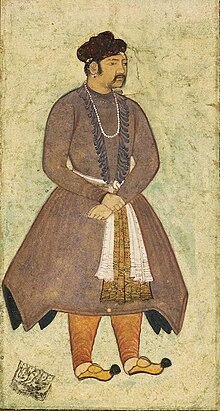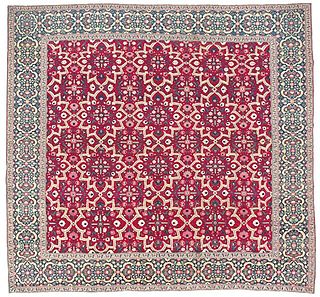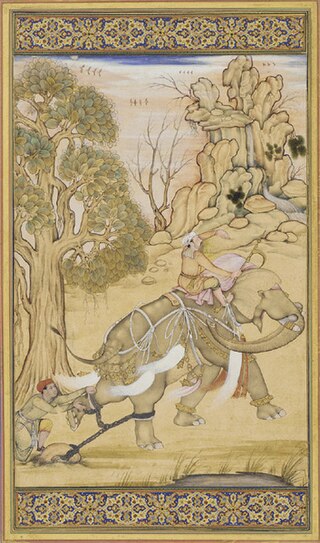
Katzeb (kamarband, Kayabandh, Cummerbund) was an article of dress encircling the body, at the waist with ends hanging in the front. It was a kind of sash also called Patka. [1] [2] [3] [4]

Katzeb (kamarband, Kayabandh, Cummerbund) was an article of dress encircling the body, at the waist with ends hanging in the front. It was a kind of sash also called Patka. [1] [2] [3] [4]
Katzeb is a compound word. The Sanskrit word Kati means waist, and Zeb in Persian means adorn. Mughals wore it over the Jama (coat). The Katzeb is a girdle named by the third Mughal emperor Akbar who was very fashion enthusiastic and gave a new name to many contemporary costumes. These are described in Ain-i-Akbari by Abu'l-Fazl ibn Mubarak. [1] [5] [6] [7] [8] [9]
Katzeb was a small rectangular piece of cloth but it was an essential garment of the dress that includes a jama (a coat), shawl, turban tanzeb (trouser). There are many Mughal paintings of the emperors with a sword or dagger tucked in Katzeb. [10] [11]
The katzeb is simple cloth belt like garment possible with many variants such as plain, laced, embroidered, brocaded or printed. [7]
Narwar is a town and a nagar panchayat in Shivpuri district in the Indian state of Madhya Pradesh. Narwar is a historic town and the Narwar Fort is just east of the Kali Sindh River and is situated at a distance of 42 km from Shivpuri. Narwar was known as Narwar District during the times of Gwalior State. It is mentioned as Nalpura in many medieval Sanskrit inscriptions. The Narwar Fort is surrounded by the Kali Sindh River. There are three dams, Harsi Dam, Mohini Sagar and Atal Sagar. Presently the Fort is being renovated by the Archaeological Survey of India.

The Akbarnama, is the official chronicle of the reign of Akbar, the third Mughal Emperor, commissioned by Akbar himself and written by his court historian and biographer, Abu'l-Fazl ibn Mubarak. It was written in Persian, which was the literary language of the Mughals, and includes vivid and detailed descriptions of his life and times. It followed the Baburnama, the more personal memoir by his grandfather, Babur, founder of the dynasty. It was produced in the form of lavishly illustrated manuscripts.

Farrukh Beg, also known as Farrukh Husayn, was a Persian miniature painter, who spent a bulk of his career in Safavid Iran and Mughal India, praised by Mughal Emperor Jahangir as "unrivaled in the age."

The Mughal Empire had a number of imperial flags and standards. The principal imperial standard of the Mughals was known as the alam. It was primarily moss green. It displayed a lion and sun facing the hoist of the flag. The Mughals traced their use of the alam back to Timur.

In the ancient Punjab region, people wore cotton clothing. Both men and women wore knee-length tops. A scarf was worn over the tops which would be draped over the left shoulder and under the right. A large sheet would be further draped over one shoulder which would hang loose towards the knees. Both male and female wore a dhoti around the waist. Modern Punjabi dress has retained this outfit but over its long history has added other forms of dress.

History of clothing in the Indian subcontinent can be traced to the Indus Valley civilization or earlier. Indians have mainly worn clothing made up of locally grown cotton. India was one of the first places where cotton was cultivated and used even as early as 2500 BCE during the Harappan era. The remnants of the ancient Indian clothing can be found in the figurines discovered from the sites near the Indus Valley civilisation, the rock-cut sculptures, the cave paintings, and human art forms found in temples and monuments. These scriptures view the figures of human wearing clothes which can be wrapped around the body. Taking the instances of the sari to that of turban and the dhoti, the traditional Indian wears were mostly tied around the body in various ways.

Mughal clothing refers to clothing adhered by the Mughals in the 16th, 17th and 18th centuries throughout the extent of their empire. Much of them were already being used in the past centuries before their arrival in Indian subcontinent. It was characterized by luxurious styles and was made with muslin, silk, velvet and brocade. Elaborate patterns including dots, checks, and waves were used with colors from various dyes including cochineal, sulfate of iron, sulfate of copper and sulfate of antimony were used.

The term jama refers to a long coat which was popular in South Asia during the early modern era.
Khasa was a high-quality variety of calico cloth that was manufactured and used for clothing in the Mughal Empire.

Mughal karkhanas were the manufacturing houses and workshops for craftsmen, established by the Mughals in their empire. Karkhana is a Hindustani language word that means factory. These karkhanas were small manufacturing units for various arts and crafts as well as for the emperor's household and military needs. karkhanas were named and classified based on the nature of the job. For example, 'Rangkhana' and 'Chhapakhana' were for textile dyeing and printing work. The term 'tushak-khana' was used to describe workshops that made shawls and embellished them with embroidery or needlework. Imperial or Royal Karkhanas were for luxury goods and weapons. The karkhanas were the place for various production activities and also for the exploration of new techniques and innovations. Some operations such as weaving, embroidery work, and brocade work were often done under one roof, resembling an integrated assembly line.

Mughal carpets were the handwoven floor coverings used in the Mughal Empire in their courts. Mughal carpets and rugs have their roots in India since the 16th and 17th centuries. Mughal carpets were a blend of Persian and Indian artistry uniquely designed with scenic landscapes, floral, and animal patterns. Kashmir was producing the finest wool and silk carpets and rugs, including prayer rugs. Sometimes the knot density in these rugs was so fine and tight as 300 knots per square centimeter.
Chautar or Chaotaer is an old cotton fabric of the Mughal period. The chautar was a mulmul variety, and the finest mulmul was termed as "Mulmul Shahi" in Hindi and Persian languages. It was produced in Eastern India. Way back, Chittagong was exporting this cloth. Conceivably then cloths were produced in smaller pieces only since the Chautar is described as a piece good. It has been recorded with specific dimensions, i.e., length 12.44 meters and width 77.75 centimeters. Chautar was compared with sansuo, which was a three shuttle cloth, type of fine cotton variety produced at Songjiang.
Peshwaj was a ladies outfit similar to a gown or jama coat with front open, tied around the waist, having full sleeves, and the length was full neck to heels. Peshwaj was one of the magnificent costumes of the mughal court ladies. The material was used to be sheer and fine muslins with decorated borders of zari and lacework.
Yalek was an underslip, a ladies garment older than 500 years of the Indian subcontinent. Yalek was a long vest type undergarment, sticking to the body, and the length was down to ankles. The ladies wore Yalek underneath the gowns and other costumes. Both Hindus and the Muslim ladies wore similar dresses except few changes.

Farzi refers to an outer garment of the Mughal court. It was a coat with short sleeves and fur collars, opened in front. The length was shorter than Jama. Farzi was a winter's garment. Mughal emperors and courtiers were wearing it over the Jama, fastened with a decorated piece of cloth, i.e., Katzeb around the waist area with loosely hanging ends. Farzi was one of the costumes given in Khilat to the Mughal nobles and other courtiers. The coat was very much famous in the 17th century among the royals.

Izarband(naada, izārband, Izar band, Kamarband, Kamar Ki Patti and Patka, ازار بند) is a kind of girdle. Izarband is used to tie the upper part of various dresses such as salwar, pajamas, ghagra, petticoat, etc., in the Indian subcontinent. The said garments have the upper side turned inwards and stitched to make a narrow tubular passage, in which the izarband passes, there is one opening in the front side to collect and tie/ knot the ends. Izarband was one of the accessory (closures) items of textiles produced in the Punjab region. The Izarband is similar to a drawstring but narrower than a katzeb or a sash.

Terlig, also known as tieli or bianxianao or Yaoxianao[zi] in Chinese, or commonly referred as Mongol dress or plait-line robe, is an archetypal type of Mongol clothing for men.
Chiltah was a Mughal period outer garment. It resembled a quilted coat. Chiltah was a royal garment. Jahangir, the fourth Mughal Emperor, wore a nadiri garment with a chiltah.

Nadiri was a type of a overcoat that was specifically reserved for the Mughal emperor Jahangir and his esteemed courtiers. The vest was an invention of his own, which he had named 'Nadiri'. Nadiri was known as kurdi among the people in Persia. The term 'nadiri' was meant to refer to rarity.

Farrukh Chela was an Indian miniature painter during the reign of Akbar, the third Mughal Emperor. As a prolific artist, he contributed to most of the major illustrated manuscripts at the Mughal court.